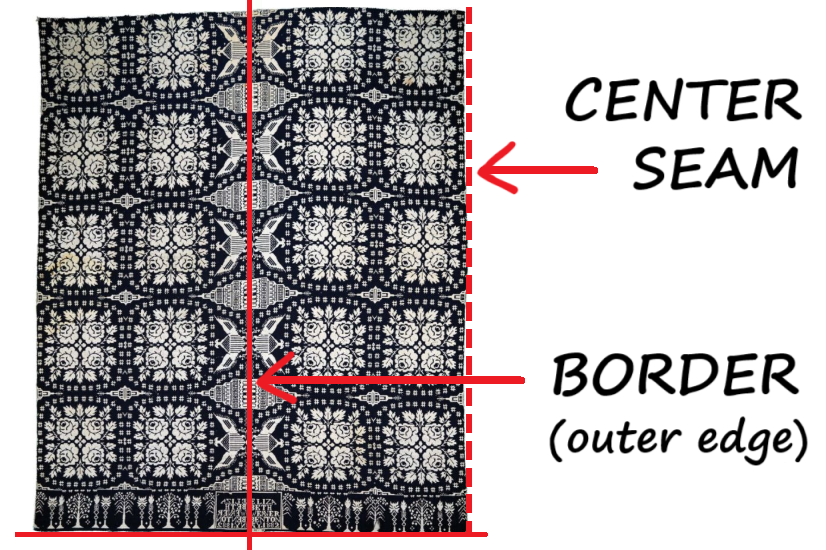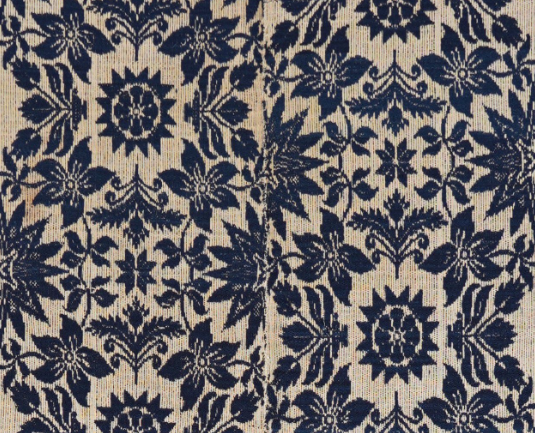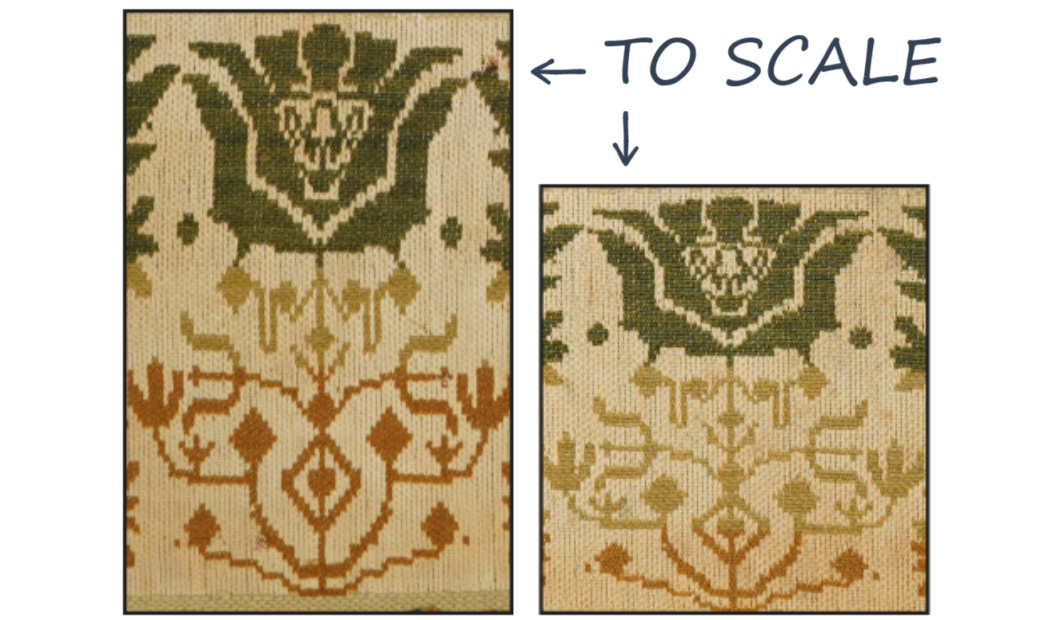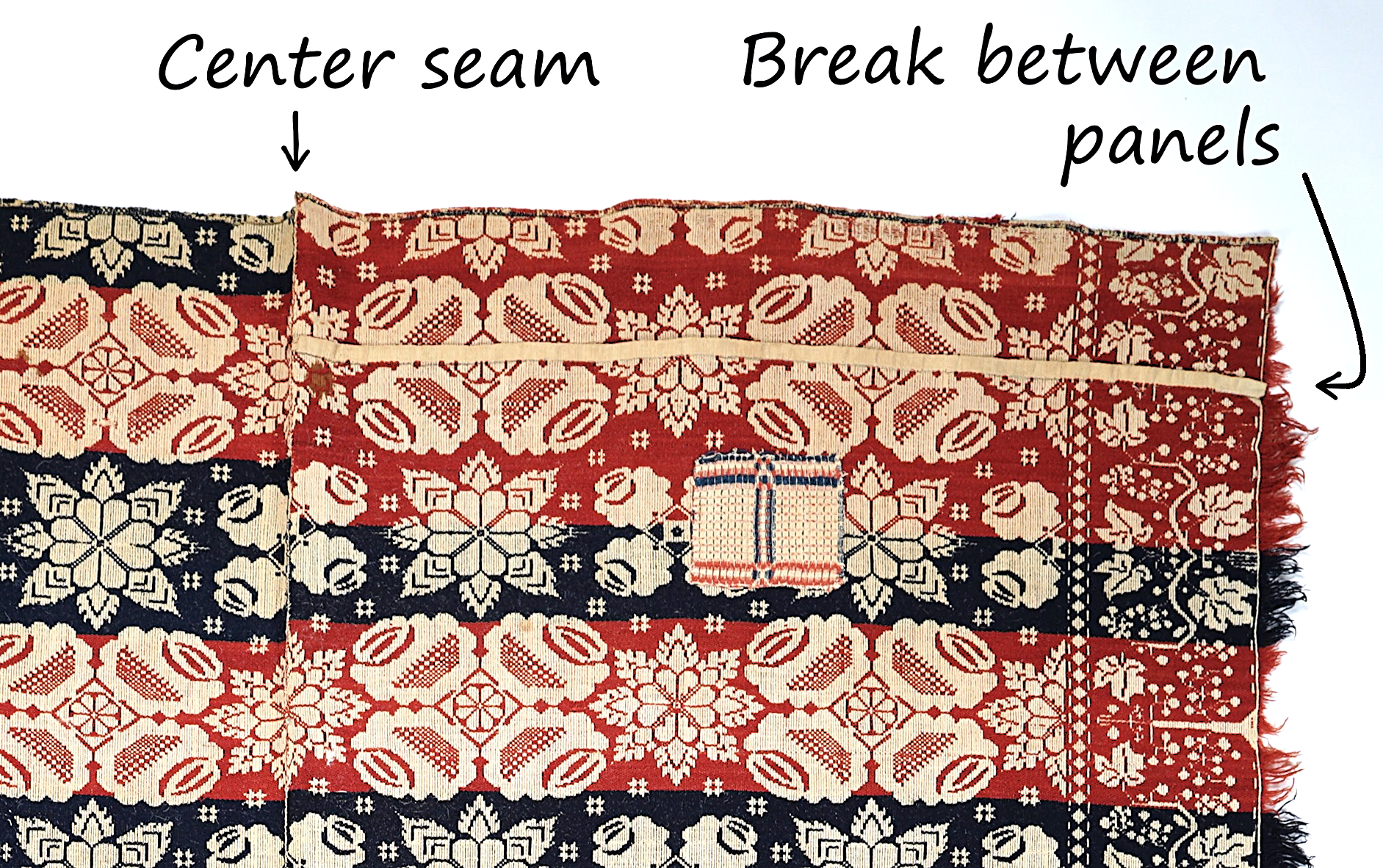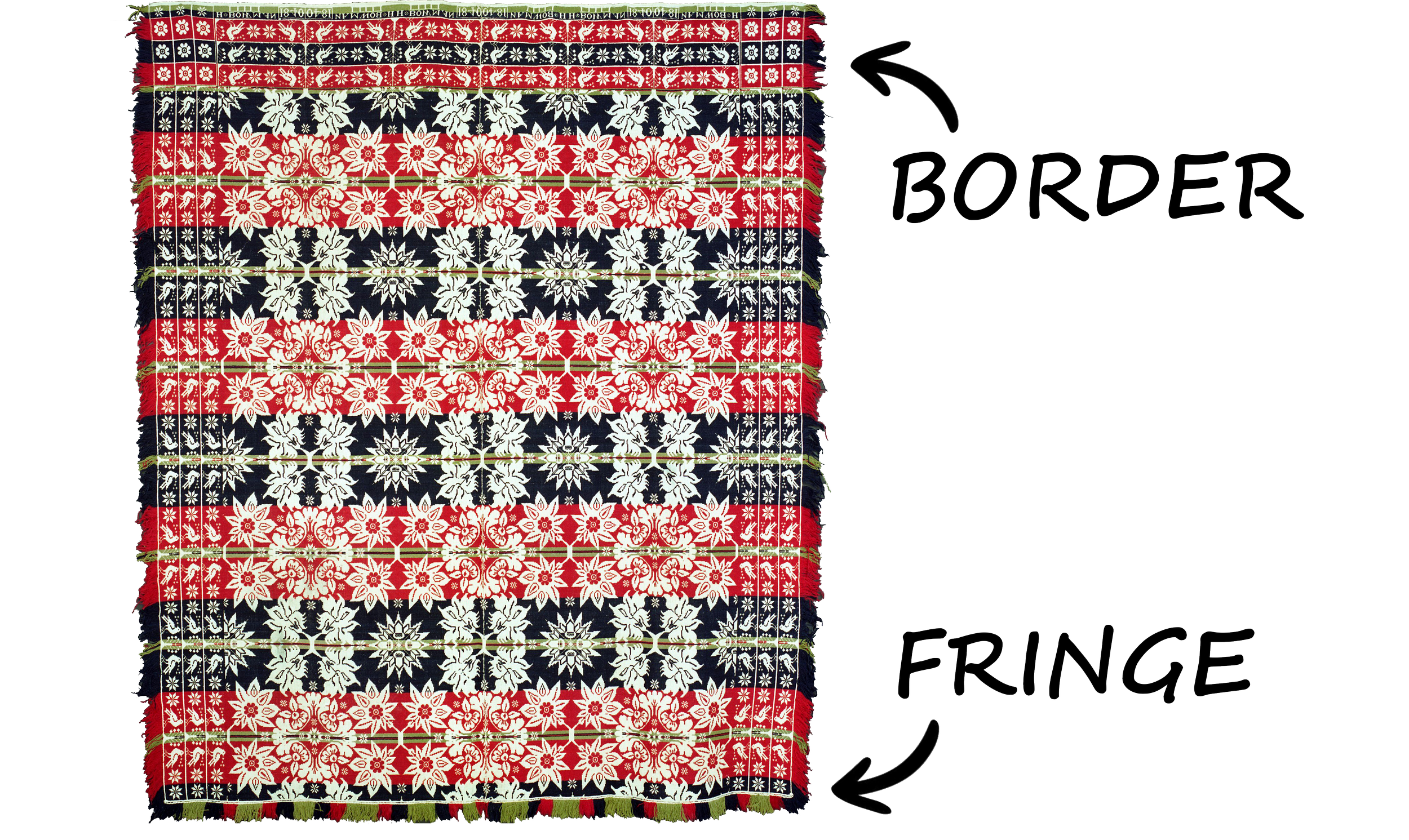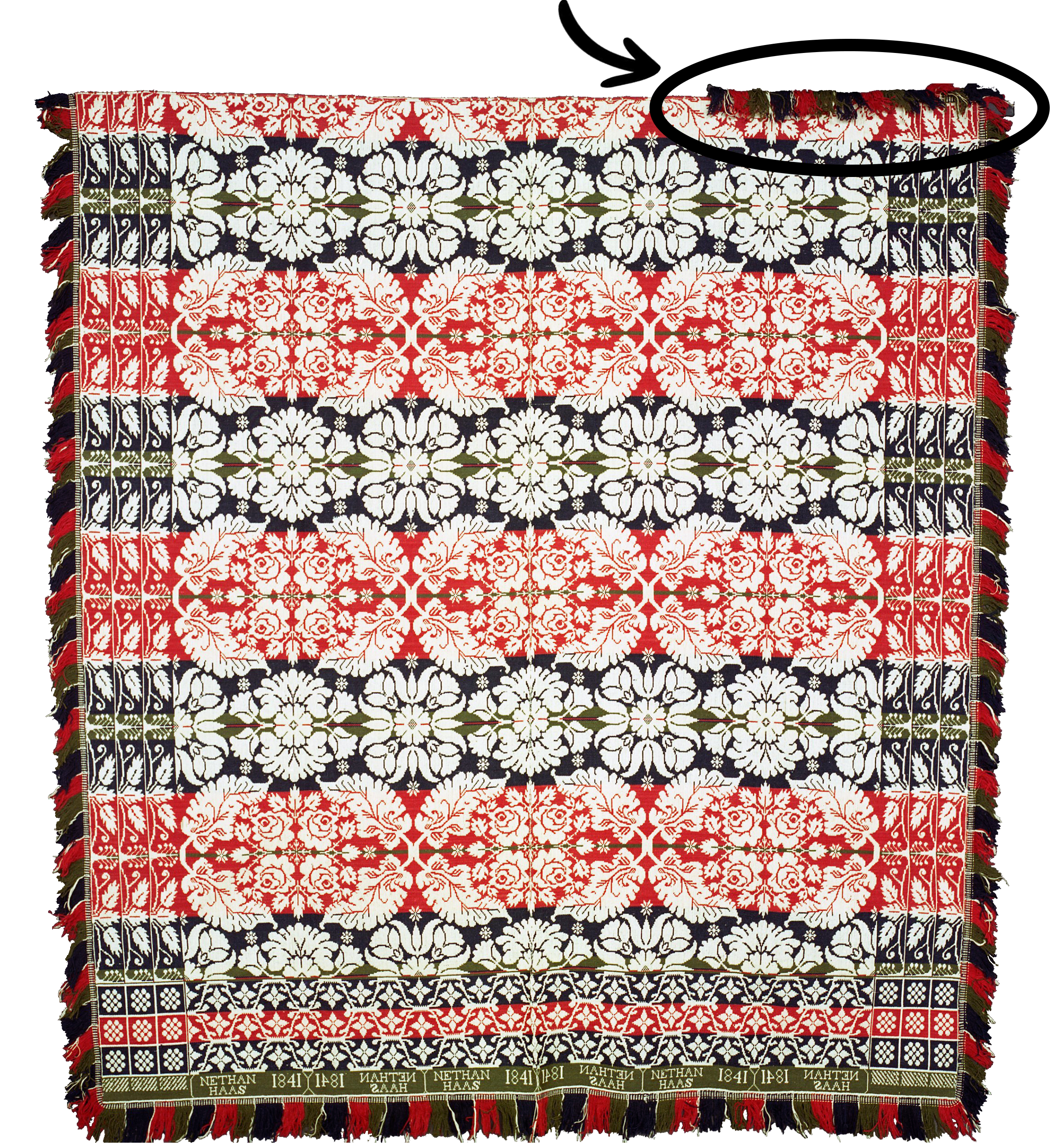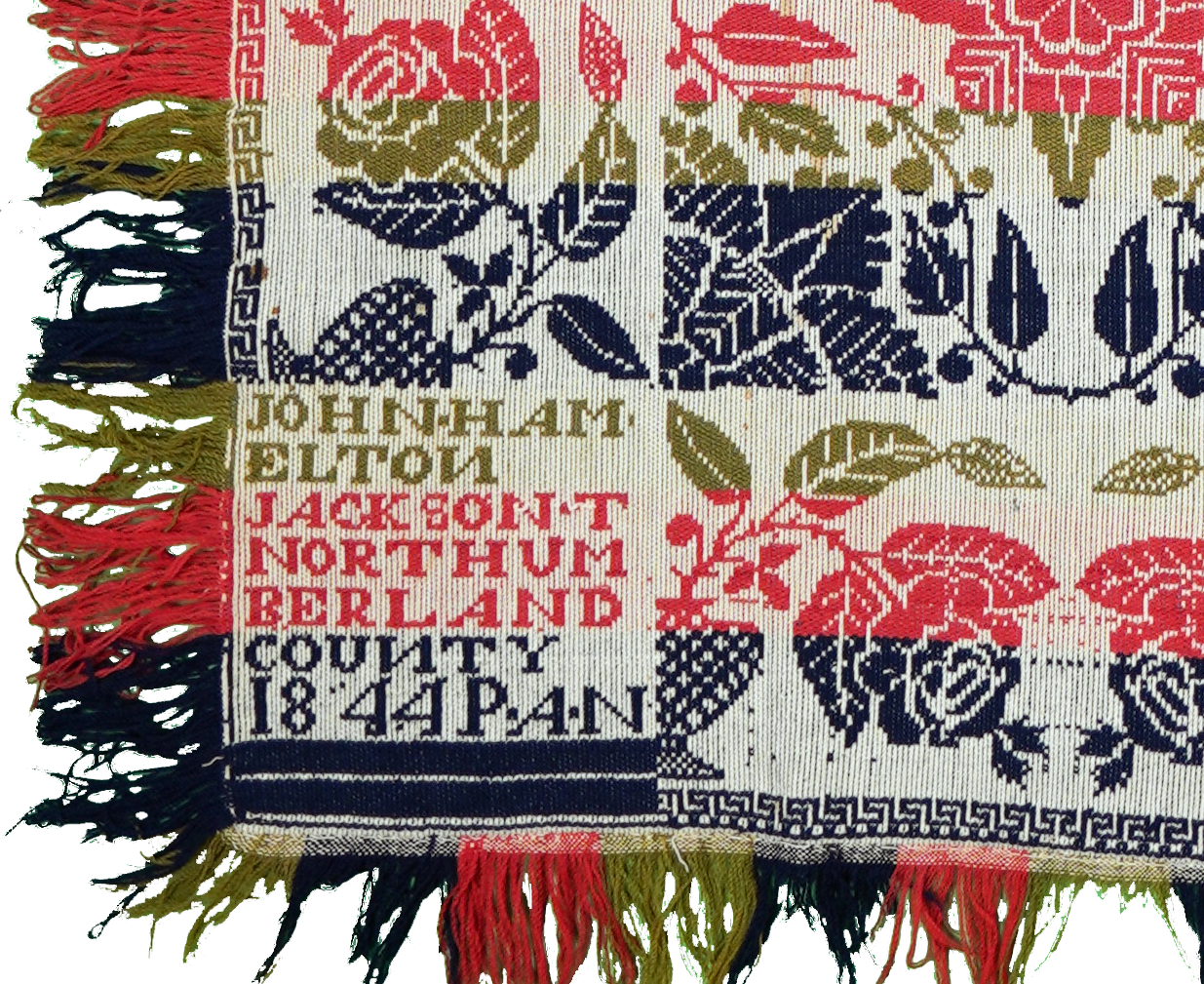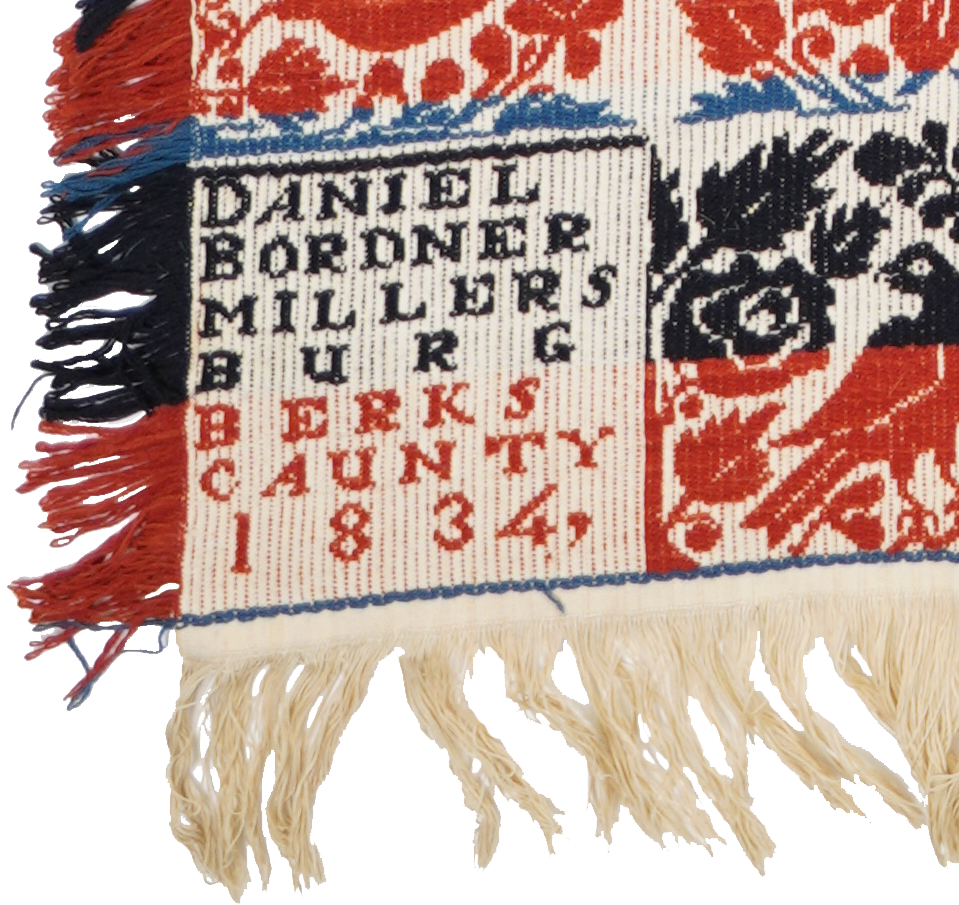The tour below provides a guide to the 30 coverlets on display in the exhibition “Practically (im)perfect.” Each stop on the tour includes a link to view the full coverlet in our online catalog. Scroll down for the audio tour, narrated by Saint Vincent College history major Isabella Jolly.
Self-guided tour
-
![]()
① Uncut coverlet
Most coverlets were woven on looms less than 40 inches wide. To reach the size of a full bed cover, coverlets were woven in two matching panels, each half the width of the finished coverlet. Once off the loom, the panels would be cut apart, hemmed, and joined with a center seam. For some reason, the owner never completed that task with this coverlet. It is a rare example of a coverlet that remains in its pristine original condition, just as it was when it came off the loom.
This figured tied double cloth coverlet was woven by Jacob Witmer in 1843 for Barbara Shenk in Manor Township, Lancaster County, Pennsylvania. Courtesy of the John and Janet Simmermaker Collection.
-
![]()
② Backward border
This coverlet was woven in two panels, each with borders on one side and one end. Instead of arranging the panels with borders on the outside edges, the borders were joined together along the center seam. The weaver did not do the sewing, so this might have been done by the coverlet’s owner or it could have happened much later. Seams were sometimes undone to make laundering easier, after which the panels could be reattached inside-out to even out the wear.
This figured double cloth coverlet was woven in 1832 for Elizabeth Weaver in Benton, Yates County, New York by an unknown weaver. Courtesy of Marty Schlabach and Mary Jean Welser.
-
![]()
③ Misaligned seam
The weaver did a poor job of matching the pattern in the two halves of this coverlet. He packed the weft down densely in some areas and more loosely in others, resulting in a pattern repeat that compresses down to 13.25 inches at the shortest and stretches out to 15 inches at the longest. These two extremes, found at the bottom border of the left and right panels, respectively, were the very first and very last pattern repeats that the weaver wove.
This figured tied double cloth coverlet was woven by Colin C. Porter in 1846 at Porter’s Factory in Jefferson County, Virginia. Gift of the McCarl Foundation.
-
![]()
④ Mismatched panels
The two panels of this coverlet are wildly different in length, measuring 84 inches on the left side and just 77 inches on the right. Considering how skewed the textile is, it is remarkable that the pattern was made to match so well at the center seam, notwithstanding a certain degree of puckering. The corner block inscriptions are also upside-down, but this can safely be attributed to the preference of the weaver rather than to an accidental error.
This figured double cloth coverlet is attributed to Josiah Sherman. It was woven in 1840 in Tuscarora, Livingston County, New York. Gift from the University of Maryland.
-
![]()
⑤ Inconsistent length
This sample-sized coverlet does not show off John Cleever’s best work. In addition to fringe that is not long enough for three sides and is attached to the wrong side, the pattern is compressed on one side and stretched out on the other. This is due not to an irregular beat, but to a difference in the number of pattern picks on each side. It seems that Cleever was using this piece to figure out how to work the pattern. He wove coverlets from 1841 to 1846, which places this sample in the middle of his weaving career.
This figured tied double cloth coverlet sample was woven by John Cleever in 1843 in Easton, Northampton County, Pennsylvania. Gift of the McCarl Foundation.
-
![]()
⑥ Mismatched panels
William Fasig accidentally wove one of this coverlet’s panels with one less repeat than the other. As usual, he wove a section of plainweave between the panels, where they were intended to be cut apart and hemmed. But due to the mismatched number of pattern repeats, the plainweave section falls six inches off of the actual center point. To make the best of it, the panels were cut to equal lengths. The plainweave section, now within the left panel, was pinched to the back and tidily hemmed out of the way.
This figured tied double cloth coverlet was woven by William Fasig in 1850 in Martinsville, Clark County, Illinois. Courtesy of Jeffrey Payne.
-
![]()
⑦ Ran out of color
If a weaver ran out of a particular color part- way through weaving a coverlet, the solution could simply be to stop using that color and replace it with another in order to complete the coverlet. The weaver of this coverlet ran out of red yarn half-way through the second panel and continued to weave with solid yellow in its place.
This geometric overshot coverlet was not signed or dated by its anonymous weaver. Courtesy of the Peter Jensen Collection.
-
![]()
⑧ Logwood vs. Indigo
Some errors are only revealed with time. When it was first made, this coverlet was likely a monochrome combination of undyed cotton and dark wool. The wide band at the bottom (and a thin stripe in the middle) preserve the original color of the wool. The tan portions have since faded. They were probably dyed with logwood, which is notoriously prone to extreme fading. The weaver would not have noticed that he was mixing up bobbins of indigo-dyed yarn with bobbins of logwood-dyed yarn, since they started out the same color.
This figured double cloth coverlet was woven in 1845. It is attributed to New York state based on the style and pattern. Courtesy of the Peter Jensen Collection.
-
![]()
⑨ Logwood vs. indigo
A mixture of yarns dyed with indigo and logwood probably explains the odd color stripes in this coverlet. The warp combines blue and tan wool in a thick-and-thin striped pattern that seems too irregular to be intentional, but the 2.5-inch section of navy blue weft in the middle of the left panel seals the deal. It is hard to imagine the weaver using such a discordant color here, unless the colors were originally indistinguishable. While the indigo-dyed navy yarn remains colorfast, the logwood-dyed yarn has faded since the coverlet was made. Originally, it would have been a uniform blue and white.
This figured double cloth coverlet is attributed to New York state based on the style and pattern. It is not signed or dated. Courtesy of Marty Schlabach and Mary Jean Welser.
-
![]()
⑩ Wrong color
Not all color errors are dramatic or obvious. A narrow stripe of blue weft yarn interrupts the color pattern in the middle of this coverlet. It is unclear why the weaver threw four picks of blue halfway through a green color block and then switched right back to the correct color. In any case, he only made the error in one of the two panels, which explains why the blue stripe only goes halfway across the coverlet.
This figured double cloth coverlet is not signed or dated. Based on the style and colors, it was probably woven in Ohio or Indiana. Private collection.
-
⑪ Caustic dye
Chemical malpractice by the dyer is causing this coverlet to unravel. A plainweave ground cloth is formed by an undyed cotton layer in the warp and weft. For every two natural cotton warp threads, there is a supplementary warp thread of thinner brown cotton. This is supposed to interlace with the wool pattern weft and attach it securely to the ground cloth. A caustic substance was used to dye these threads brown, which has caused them to disintegrate throughout much of the textile over time. Long, loose floats of wool pattern weft are left wherever the brown tie- down threads have crumbled to dust.
Coverlets with this star logo in the corner block are usually attributed to Matthias Mann in York County, Pennsylvania based on the style and pattern. Courtesy of the Peter Jensen Collection.
-
![]()
⑫ Long & short fringe
The two panels of this coverlet are woven nearly identically, producing a pattern that matches well enough to look seamless. Despite this precision, another obvious detail was overlooked. The short fringe on the right half of the coverlet measures two inches long, while the fringe on the left panel measures a full four inches. The two sides were never trimmed to match.
This figured double cloth coverlet was woven by an unidentified weaver in 1844 for J. Braymer. Based on the client names that appear in coverlets with this pattern, it has been attributed to Saratoga County, New York. Gift of Foster and Muriel McCarl.
-
![]()
⑬ Dark & light fringe
In double weave, two layers of cloth are woven simultaneously. The pattern is formed as threads from the light layer and the dark layer switch positions on the front and back face of the textile. As the fabric transitions into fringe at the bottom edge, the left panel ends with all threads in the dark layer on top but the right panel ends with all threads in the light layer on top. This could be a manufacturing error by the weaver, or it could have happened later as threads at the edge unraveled with time and use.
This figured double cloth coverlet was woven by Samuel Graham in 1849 in Newcastle, Henry County, Indiana. Gift of Foster and Muriel McCarl.
-
![]()
⑭ Upside-down fringe
This coverlet is typical in having borders and fringe on three sides. Unlike the typical arrangement, however, the borders and fringe are on opposite ends. While the side fringe is formed by extending the wool weft threads beyond the selvedge, the bottom fringe was woven separately and sewn “upside-down” onto the borderless end, probably by its owner. It looks like a mistake compared to how the vast majority of coverlets were put together, but it is also possible that this was simply the owner’s preference.
This figured tied double cloth coverlet was woven by Henry Bowman in 1840 in Lancaster County, Pennsylvania. Gift of Foster and Muriel McCarl.
-
![]()
⑮ Lopsided fringe
If the entire fringe was woven separately, it did not always perfectly match the length required to go around three sides of the coverlet. If it was too long, many chose to wrap the fringe around the top edge rather than waste a valuable commodity by cutting it to the proper length. Often it was wrapped around symmetrically, so there was the same amount of extra fringe on both sides. That is not the case here, where all of the extra was sewn onto one side.
This figured tied double cloth coverlet was woven in 1841 for Nethan Haas in Manheim, Lancaster County, Pennsylvania. Ron Walter has attributed it to Benjamin Endy. Gift of Foster and Muriel McCarl.
-
![]()
⑯ Truncated pattern
Other coverlets with this pattern, known as ‘Boston Harbor,’ show a collection of sailing ships and steamboats in each pattern repeat. The weaver removed a number of pattern rows in this coverlet to cut out the harbor scene and one row of buildings, but he did not adjust the pattern punch cards to eliminate the tips of the ship masts. These remnants of the full design now appear to be random squiggles between each truncated pattern repeat.
Few (if any) coverlets with this pattern are signed or dated. Based on the style, this figured double cloth coverlet was probably woven in Ohio. Gift of Foster and Muriel McCarl.
-
![]()
⑰ Misinterpreted draft
This coverlet is a unique take on the popular “Double Bowknot” pattern. Traditionally, the threading is mirrored in every repeat to make large, symmetrical X-shaped motifs. Here, the threading pattern simply repeats without reversing. It is impossible to know whether the weaver misunderstood how the pattern was supposed to work or altered it intentionally for an original effect. Rural domestic weavers sometimes wrote down their patterns, using various methods of shorthand, to pass around to other weavers. It was almost inevitable that misinterpretations would occur.
This geometric overshot coverlet was not signed or dated by its anonymous weaver. Transfer from the American Textile History Museum.
-
![]()
⑱ Tie-up error
The error in this coverlet is subtle and confined to the bottom left border. A loom with 16 shafts was needed to weave the pattern. Each shaft, operated by foot treadles, controls a particular set of warp threads. The treadles were not attached to the correct shafts when the weaver began, which initially threw off the intended pattern. Within inches, he had quickly remedied the problem by re-tying the treadles to the correct shafts. The error is not repeated in the second panel; apparently, it was not worth the weaver’s effort to undo the correction.
This geometric double cloth coverlet was not signed or dated by its anonymous weaver. Gift of Foster and Muriel McCarl.
-
![]()
⑲ Treadling and color
The weaver must have lost track of the pattern toward the top of this coverlet, where the treadling has been reversed to produce O’s instead of X’s. Something odd also happens with the colors at the bottom edge, where the red and green yarns are reversed in comparison to their placement throughout the rest of the coverlet. Interestingly, the color reversal is nearly invisible on the other side. Whatever the reason for these irregularities in pattern and color, the weaver carefully repeated them in both panels to make the two sides match.
This geometric overshot coverlet was not signed or dated by its anonymous weaver. Gift of Foster and Muriel McCarl.
-
![]()
⑳ Mismatched dates
This coverlet has different dates in the left and right corner blocks. The center seam tells us that it was woven in two panels, end-to-end, which means that one corner block was the very first part of the coverlet that Daniel Fisher wove and the other corner block was the very last. The likeliest explanation is that Fisher started the first panel in December and finished the second panel in January of the new year. The mismatched dates may not technically be a mistake, but they certainly stand out as a curiosity.
This figured tied double cloth coverlet was woven by Daniel Fisher in South Bend, St. Joseph County, Indiana. Gift of the McCarl Foundation.
-
![]()
㉑ "MANUFACTOR(E)D"
“Manufactured” was a difficult word for weavers. Here, Solomon Kuter spells it MANUFACTORED in the lower right corner block but MANUFACTORD in the lower left. Other weavers use several additional creative spellings. The problem is not even solved by using a simpler word like “made,” which weavers have been known to spell as “MAIDE” or “MATE.”
This figured tied double cloth coverlet was woven by Solomon Kuter for Maria Wagner in Trexlertown, Lehigh County, Pennsylvania in 1838. Gift of Timothy and Sherryl K. Davidick and sons.
-
![]()
㉒ "WEVER" & dye
In addition to the unique spelling of “WEVER,” you may also notice variation in the depth of the indigo dye in this coverlet. Some areas are noticeably lighter than others. In order to get a consistently dark navy-blue color, yarn or fabric was dipped into an indigo dye vat multiple times. It would be light blue after one dip and grow darker with each successive dip. The yarns in this coverlet appear to have come from different dye lots that weren’t perfectly consistent.
This figured double cloth coverlet was woven by Nicholas Young (initials “N.Y.”) for Elizabeth Hedley in Pine Brook, Morris County, New Jersey in 1839. Gift of Foster and Muriel McCarl.
-
![]()
㉓ "WOOVE"
It seems that weaver George Stich could not decide on which spelling to use. His 1839 coverlets read both “WOOVE” and “WOVE” at Newark, Ohio. He uses two O’s through 1842, and then finally seems to settle on a single O in coverlets woven in 1845 and later. Although modern Americans would say “woven,” it was common in the 19th century to say “wove” in this context. That much, at least, reflects a change in the language rather than a grammatical mistake.
This figured doubleweave coverlet was woven in Newark, Licking County, Ohio in 1840. It is attributed to George Stich, who signed similar coverlets with his name and this location. Courtesy of Jeffrey Payne.
-
![]()
㉔ Illegible inscription
A group of coverlets with patriotic and masonic motifs in the borders, attributed to New York state, share a similar corner block design that ends with “WOVE IN” and the date. Some of these inscriptions begin with a legible client name, but many others begin with gibberish, as seen here. The reason for this is unclear, but in any case, the weaver saw fit to produce these garbled inscriptions over the course of many years. Surviving examples range from 1833 to 1847.
This figured doubleweave coverlet was woven in 1840 by an unidentified weaver. It is attributed to New York state based on the style and imagery, which includes patriotic and masonic motifs. Gift of Foster and Muriel McCarl.
-
![]()
㉕ Backward letters
Backward letters are a common coverlet “typo.” The most commonly reversed letters seem to be N, R, and S. Here, John Hamelton reverses the direction of just two of the seven N’s in his corner block inscription. From 1836 to 1844, Hamelton never fixed the backward N’s in his signature, despite making periodic updates in his inscription to reflect the current year, a move from Machenoy to Jackson Township, and occasional client names (some of which he misspelled).
This figured tied double cloth coverlet was woven by John Hamelton in Jackson Township, Northumberland County, Pennsylvania in 1844. Gift of Foster and Muriel McCarl.
-
![]()
㉖ "TOUNSCHIP"
Many weavers were not native English speakers, or were influenced in their spelling by their ethnic heritage. Although Daniel Snyder was born in Pennsylvania, his use of SCH reflects German influence. It is interesting that German-born weaver John Cleever used an identical inscription style for a coverlet that he wove in nearby Forks Township: “MADE.BY / J.CLEEVER / FORGS / TOUNSCHIP / NOR T. CO / 1841.”
This figured tied double cloth coverlet was woven in Hanover Township, Northumberland County, Pennsylvania by Daniel Snyder in 1841. Transfer from the American Textile History Museum.
-
![]()
㉗ "CAUNTY"
Daniel Bordner wove coverlets in Berks County, Pennsylvania from 1833 to 1845. In 1833, Bordner signed his coverlets “BERKS C.” In the following year, as seen in this coverlet, he expanded the abbreviated “C.” to a misspelled “CAUNTY.” He reverted to the abbreviation “B.C.” on some 1835 coverlets, but by the end of the year he was spelling out “BERKS COUNTY” (now spelled correctly), which he continued to inscribe on all coverlets that he wove from that point onward.
This figured tied double cloth coverlet was woven in Millersburg, Berks County, Pennsylvania by Daniel Border in 1834. Gift of Foster and Muriel McCarl.
-
![]()
㉘ Scrambled pattern
The scrambled motifs in this coverlet look out of focus around the edges, where the colors transition from light to dark. This was caused by a technical error when the warp was set up on the loom. Each unit of the doubleweave pattern consists of two dark and two light warp threads. Something went wrong in how these threads were ordered, causing their positions to flip in unintended ways. This mistake could have been made by a beginner or by an experienced weaver getting used to new equipment.
This figured double cloth coverlet was woven by an unidentified weaver in 1838. Based on the style and pattern, it is attributed to New York state. Courtesy of the Kitty Bell & Ron Walter Collection.
-
![]()
㉙ Hook marks
The dots in this pattern are evidence of malfunctioning equipment. The Jacquard machine manipulates individual threads with a system of hooks and leashes. Holes in the punchcards mechanically instruct the machine to lift a certain set of hooks and the warp threads that are attached to them. A bent hook may repeatedly stick in the wrong position and fail to lift a certain set of warp threads, peppering the pattern with discordant dots.
This figured tied double cloth coverlet was woven by Nicholas Beaver at Keagy’s factory in Bedford County, Pennsylvania. Gift of Foster and Muriel McCarl.
-
![]()
㉚ Double bowknot
This “Double Bowknot” overshot pattern (above right) is threaded and treadled correctly, in two halves that mirror each other. Compare this with the asymmetrical pattern in coverlet number 17, which was almost certainly intended to look like this one. In coverlet 17, the weaver simply repeated one half of the pattern without reversing the order of the threading and treadling.
This geometric overshot coverlet was not signed or dated by its anonymous weaver. Transfer from the American Textile History Museum.
Audio tour
Narrated by Isabella Jolly, history major, SVC ‘26


